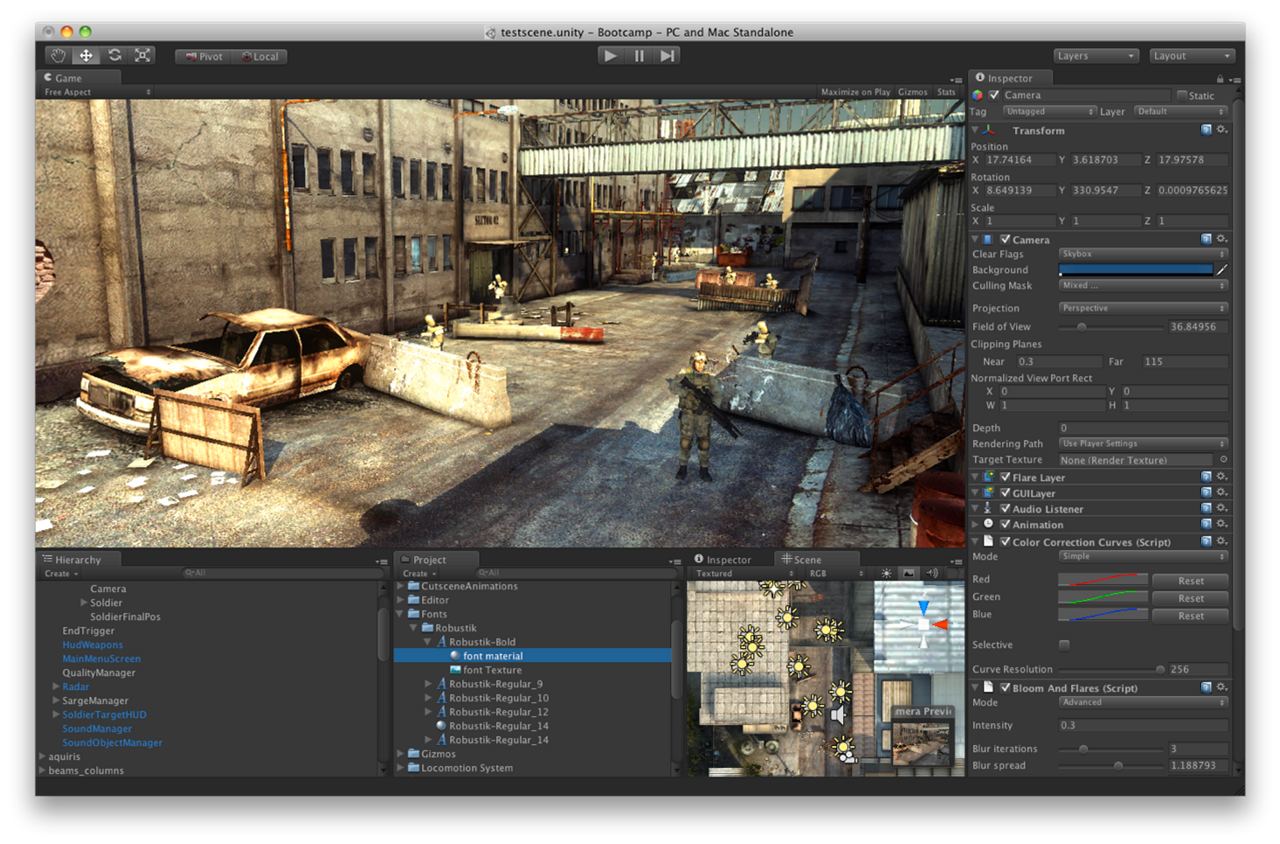Game Engines: Driving the Future of Gaming

Key Takeaways
- A game engine is the underlying software framework that makes a game function, from graphics, physics, input, sound, scripts and AI behaviors.
- Game engines provide developers with the necessary tools and automate many core processes to help save time and money. This gives them more time to focus on writing gameplay code or customizing unique elements like character models, textures, how objects interact, etc.
- Game engines help companies outside of gaming to visualize data, products, and processes in new ways and to develop creative ways to collaborate and innovate. Their robustness, efficiency, and versatility are of vital importance for the development of the Metaverse.
- The most advanced game engines have reached an unprecedented level of dominance in the global video game industry, including Unreal Engine, Unity, CryEngine, and Amazon Lumberyard.
Gaming generated $180 billion in revenue in 2020 and is expected to be worth over 200 billion USD by 2023. An underlying factor powering much of this success is the proliferation of reliable, accessible, and full-featured gaming engines. These tools reduce the complexity of game development, and they’ve empowered millions of developers to create visually stunning worlds, tell impactful stories, and immerse players in new universes.
Besides gaming, these engines are also used in many other industries, from pre-visualization in film production, to automotive modeling, and even architecture, providing unparalleled levels of design, simulation, and computing power for creators. Striving for greater fidelity in digital environments will be pivotal in building the future Metaverse, which will depend on broad interconnectivity between millions of concurrent users.
What is a Game Engine?
A game engine is a software framework or toolkit that developers use to run a game. Game engines enable creators to include visuals, physics, rendering, scripting, collision detection, AI behaviors and other functions into games. With the help of game engines, developers now can more easily and efficiently build high-quality games without incurring the enormous time commitment and costs necessary to build the underlying game engine from scratch.
Today, game engines are used to build essentially all of the most amazing and popular titles, from simple indie games to the most complex AAA games. There are no rules as to what functionality is absolutely required to be considered a game engine, however, most of the top engines share the following core features:
- Graphics: From simple 2D to intensive 3D rendering, the premier engines are able to import files from third-party softwares which allows developers to be more flexible with the graphics in their game.
- Physics: In-game immersions/physics is responsible for solving the equation of motion and for detecting collisions.
- Audio engine: To load and play sounds and music files including spoken dialogue, musical cues, sounds from objects, and ambient music in the background.
- Input: Engines convert input from players into actionable movement within the game like mouse clicks, mouse movements, key presses, controller inputs, etc
- Artificial Intelligence: AI is used in order for game environments to adapt to players’ reactions. The most common applications of AI is in the creation of non-playable characters (NPCs) and pathfinding.
- Networking: Modern engines provide complete networking frameworks for online, multi-player play, downloadable content with the goal of reducing latency between clients spread across the globe.
- Graphical user interface: Game engines enable developers to create their own custom graphical user interface (GUI) tailored to the specific style of the game.
- Scripts: Ready-made scripts that can be attached to objects in the game world which help to get a game done quickly

Unity interface
The Importance of Game Engines
The prospect of building an immersive game from scratch is often a long and costly one. Game engines provide developers with necessary tools to save time and money. This allows for more time to focus on writing gameplay code or other unique elements like character models, textures, how objects interact, etc.
Some engines are so visually oriented that they allow games to be built without writing a single line of code. Others offer versatile cross-platform compatibility, with the ability to toggle the build configuration between console, desktop, or mobile.
Here are some of the biggest advantages game engines have to offer:
- True engagement – Immerse gamers in photo-realistic worlds that they can interact with and control.
- Limitless potential – Provide a wide range of tools and resources that allow for the creation of high-quality, immersive and interactive experiences in many areas such as game development, virtual and augmented reality, education and training, film and animation, modeling and simulation, advertising and marketing, and research and development.
- Multi-platform – Versatile tools that can be applied across multiple platforms.
- Updatable – Evolve and iterate games and the virtual tools themselves as new products and solutions develop.
- Creativity – The power and potential of these tools inspire and enable greater and more ambitious systems and designs.
Game engine software was originally created by game developers for the purpose of developing new games more quickly and easily. But now, these powerful rendering tools have given other industries the opportunity to visualize data, products, and processes in new ways and to develop creative ways to collaborate and innovate. Let's take virtual reality for example; rather than having to write algorithms to build virtual settings, developers can now rely on gaming engines to do most of the hard work. Beyond virtual reality, game engines are also used for simulate real world scenarios, like foot traffic through an architectural design before breaking ground.
The Most Popular Game Engines
Different engines are tailored to different needs and levels of knowledge, so it is important for game developers to choose the one that’s best for their concept and purposes. Here are some of the most advanced game engines that have reached an unprecedented level of dominance in the global video game industry.
Unreal Engine

One of the most widely used game engines today is the Unreal Engine developed by Epic Games. The original version was released in 1998 and after 17 years and many updates, it continues to be used by some the biggest games every year. Some notable titles and series made with Unreal Engine include Fortnite, Gears of War, Mass Effect, Bioshock, The Batman: Arkham, and Final Fantasy 7 Remake.
Immersive graphics in Mass Effect
The strength of Unreal engine’s graphics processing lies in its ability to render realistic lighting in real-time through a reflection engine & dynamic global illumination. In addition, it provides a UI makeover in a faster, easier, and more efficient manner. Its source code is written in C++ which offers the highest portability, thus, supporting a wide range of Microsoft Windows, macOS, Linux, SteamOS, HTML5, iOS, Android, Nintendo Switch, PlayStation 4/5, Xbox One and VR programs.
The steady march of Unreal Engine towards industry-standard status extends to Web3 games as well. As crypto gaming platforms move beyond 2D RPGs and arcade games, Unreal Engine is fast becoming one of the top choices. Notable titles include Illuvium, Shrapnel, Phantom Galaxies, Project Eluüne: StarGarden, etc.

Illuvium graphics
The latest version, Unreal Engine 5.1, builds upon the groundbreaking feature set introduced in UE5 and enables easier and faster creation of 3D content and experiences with greater freedom, fidelity, and flexibility than ever before. Its significant improvements to Lumen, Nanite (an engine that imports high-detailed photographic source material – taking advantage of its past acquisition of Quixel) and Virtual Shadow Maps (VSM) performance; World Partition or cinematic pipelines are going to revolutionize the industry.
Unity
Unity is also a multi-platform game engine that supports interactive 3D content. From the best open-source game engine to the best engine for 2D games, Unity has everything covered. We have also seen Unity used to create mobile games. Along with this, Unity has built up a vast community and has its own Asset Store, which offers free and paid packages. Unity is compatible with Mac, Windows, Linux, Android, iOS, Switch, Xbox, PS4, Tizen and and other platforms. Recent notable titles made with Unity include Lara Croft Go, Ori and the Blind Forest, Pillars of Eternity, Temple Run, Assassin’s Creed Identity, Hearthstone, Pokémon Go, etc. In the web3 space, we have Guild of Guardians, Axie Infinity,
Unity is also one of the most web3-friendly game engines. They just announced that a Web3 software development kit (SDK) has been added to the Unity Asset Store. The SDK allows for the integration of the Tezos blockchain into games, opening the limitless possibilities of smart contracts, NFTs, crypto transactions, etc.

Ori and the Blind Forest
The most significant benefit of using Unity is its ease of use and ease of accessibility for new and independent developers, development teams, and independent or solo programmers. The user-friendly interface makes development easier and reduces the learning curve, drawing many beginners to choose Unity as their engine of choice. It uses C# and is also known for its fast iteration cycles, partly due to its ability to minimize code usage.
Enemies showcases Unity’s capabilities for powering high-end visuals in 2022
CryEngine
CryEngine, developed by CryTek is a full-featured sandbox editor that supports development for all major platforms, including Xbox, PS4, Windows PC and Oculus. It is considered as one of the best free, open-source game engines on the market that offers free licenses and incredible flexibility for developers. CryEngine also provides plenty of free educational resources like tutorials, forums, and documentation to help beginners.
“With CRYENGINE, we have a simple goal: to create the most powerful gaming engine software in the industry, and to give creators all across the globe the tools to harness this power to create world-class gaming experiences, no matter their budget or team size.” - Cytek statement
Most games that feature CryEngine have stunningly life-like graphics and Crysis 3, Kingdom Come: Deliverance, Son of Rome or Hunt: Showdown are some perfect examples of this.

Hunt: Showdown graphics

Son of Rome graphics
Amazon Lumberyard
Amazon Lumberyard is a 3D game engine designed to build games and fan communities. It offers VR preview mode, visual scripting tools, and also Twitch integration. Lumberyard’s visual technology is based on CryEngine, which means gorgeous 3D environments and a whole slew of awesome real-time effects that allow developers to create high-quality games, and connect them to the AWS Cloud. The engine has good native support for C++, P2P, and client topology. Lumberyard also supports Autodesk Maya and Adobe Photoshop.
Lumberyard is designed for effortless compatibility with Amazon Web Service and is a great game engine for beginners. Lumberyard includes everything a professional game developer expects, including a full-featured editor, native code effectiveness, and stunning visual graphics. It also comes with hundreds of ready-to-use features such as networking, cinematic sequences, the Script Canvas editor, and the Animation Editor, along with audio tools.
Some notable games built on Amazon Lumberyard include Star Citizen, Sweet Bandits' Coffence, Deadhaus Sonata, State of Survival, etc.

Deadhaus Sonata graphics
Looking Forward
Game engines have become the most powerful tools for building digital environments, advancing game design and providing a sandbox for experiment and exploration. Today, the video game market is larger than ever, and gamers are beginning to grow hungry for the next “new thing.” Whatever that may be, it’s safe to say these engines will drive this innovation forward. They started out as utilitarian game development frameworks, but since have grown far beyond their roots, with applications in numerous complex fields outside gaming. The coming decades will likely see these engines emerge as key tools for building the infrastructure of the Metaverse, offering creators a way to bring their ideas to life within vibrant virtual worlds.






Reviews